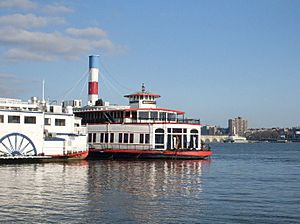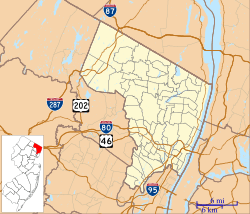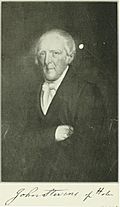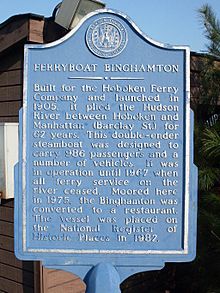Binghamton (ferryboat) facts for kids

Binghamton at Edgewater, New Jersey
|
|
Quick facts for kids History |
|
|---|---|
| Name | Binghamton |
| Operator | Hoboken Ferry Co., subsidiary of DL&W RR |
| Builder | Newport News Shipbuilding and Drydock Company |
| Laid down | 1904 |
| Launched | February 20, 1905 |
| In service | April 3, 1905 |
| Out of service | November 22, 1967 |
| Fate | Sold for restaurant conversion, 1969 |
| Status | Restaurant / nightclub (closed/dismantled), Edgewater, NJ |
| General characteristics | |
| Tonnage | 1,462 gt |
| Length | 231 ft (70.4 m) |
| Draft | 10.5 ft (3.2 m) |
| Propulsion | Double-compound reciprocating steam engine having four cylinders, rated 1,400 horsepower, taking steam from two coal-fired single-end Scotch boilers (removed) at 150 lbs working pressure, and driving a screw-propeller at each end on continuous shafting |
| Capacity | 986 passengers (plus vehicles) |
|
Ferryboat Binghamton
|
|
| Location | 725 River Rd, Edgewater, New Jersey |
| Built | 1904-05 |
| Architect | Gardner & Cox |
| Architectural style | July 9, 1982 |
| NRHP reference No. | 82003262 |
The Binghamton was a special ferryboat that carried people and cars across the Hudson River. It traveled between Manhattan and Hoboken from 1905 to 1967. This ferry was built for the Delaware, Lackawanna & Western Railroad and could hold 986 passengers.
After its ferry days, the Binghamton found a new life. It was moved to Edgewater in 1971. From 1975 to 2007, it served as a fun floating restaurant. The Binghamton was added to the National Register of Historic Places in 1982. It was likely the last steam ferry built for New York Harbor. Sadly, after years of damage, the ferry was taken apart in 2017.
Contents
How Ferries Shaped New York Harbor
Before big tunnels and bridges were built, ferries were super important in New York Harbor. Trains from the west ended in New Jersey. So, people needed ferries to cross the Hudson River to get to Manhattan. Many companies, including railroads, ran these ferry services.
A special kind of ferry, called a "double-ender," was very common. These boats had propellers and steering at both ends. This meant they didn't need to turn around, saving a lot of time. Cars could drive on one end and off the other.
The first successful steamboat in New York Harbor was Robert Fulton's North River Steamboat in 1807. Just four years later, in 1811, John Stevens started the world's first steam ferry service. It ran between Hoboken and Manhattan. The first double-ended ferries appeared in 1812. Over 400 double-ended ferries operated in New York Harbor over the years. The busiest time was from 1906 to 1908, with about 150 ferries working.
The Binghamton was part of the Hoboken Ferry Company. This company was owned by the Delaware, Lackawanna and Western Railroad. The Binghamton was one of six ferries they had. Its sister ships, the Elmira, Scranton, and Pocono, were also built in 1905. The Binghamton was the last of these historic ferries to survive.
The Binghamton's Journey
The Binghamton was built by the Newport News Shipbuilding and Dry-dock Company in Virginia. It was one of five similar ferryboats. The ferry was launched on February 20, 1905. Miss Charlotte Emery, whose father worked for the ferry company, officially named the boat.
The Binghamton was finished a month later. It sailed to Hoboken, New Jersey, and started service on April 3, 1905. Its usual trip was from the Hoboken Terminal to Barclay Street in Manhattan. This journey was about 1.75 miles and took twelve minutes. The Binghamton made this trip almost every day for over sixty years.
Over time, new ways to cross the Hudson River appeared. The Pennsylvania Railroad opened a line to Penn Station in Manhattan in 1907. The Hudson and Manhattan Rapid Transit Line opened the same year. Later, the Holland Tunnel (1927), Lincoln Tunnel (1937), and George Washington Bridge (1931) were built. These new options meant fewer people needed the ferries.
In 1960, the Delaware, Lackawanna and Western Railroad merged with the Erie Railroad. They formed the Erie Lackawanna Railway. The Hoboken Ferry Company stopped running on November 22, 1967. The Binghamton and other ferries were put up for sale.
Today, ferry service on the Hudson River has returned. Companies like NY Waterway use smaller, modern ferries. The Staten Island Ferry still uses large double-ended ferries, keeping the tradition alive.
A Star on Screen
The Binghamton even appeared in a movie! In 1948, a crime drama called Close-Up was filmed in Manhattan. A dramatic chase scene in the movie takes place outside the Hoboken Ferry terminal. Part of the scene was even filmed inside and on board the Binghamton itself. You can see many details of the ferryboat, its passengers, and crew in the film.
From Ferry to Floating Restaurant
In 1969, a contractor named Edward Russo bought the Binghamton. He wanted to turn it into a restaurant. His plan included large dining rooms and two pubs. The ferry moved to Edgewater, New Jersey, in 1971.
After some delays, the Binghamton was sold again in 1974. New owners planned to open it as a restaurant and nightclub. On February 28, 1975, the ferry moved to its new permanent spot. The restaurant, called "Binghamton's," opened later that year.
The restaurant stayed open for ten years. But it closed by late 2007. The Binghamton then sat unused at its dock in Edgewater. In May 2012, the ferry started taking on water and partly sank. It sank even more during Hurricane Sandy in October 2012.
In May 2013, there was a fire on the ferry. The owner said there was no major damage. He planned to have someone remove the ferry and open a new restaurant on a barge. The demolition of the Binghamton began on July 26, 2017. It was completed by mid-2017. There were hopes for a new floating restaurant called Binghamton II, but it hasn't happened yet.
Gallery
The Binghamton at Edgewater, NJ. Photos by T.E. Rinaldi, September 2004.
The Binghamton in May 2012
The Binghamton in June 2015
The Binghamton in June 2017, the week of its removal




















